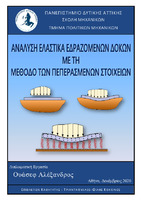| dc.contributor.advisor | Κόκκινος, Φίλης-Τριαντάφυλλος | |
| dc.contributor.author | Ουάσεφ, Αλέξανδρος | |
| dc.date.accessioned | 2021-06-29T06:43:38Z | |
| dc.date.available | 2021-06-29T06:43:38Z | |
| dc.date.issued | 2021-01-15 | |
| dc.identifier.uri | https://polynoe.lib.uniwa.gr/xmlui/handle/11400/719 | |
| dc.identifier.uri | http://dx.doi.org/10.26265/polynoe-570 | |
| dc.description.abstract | Η ανάλυση της συμπεριφοράς δοκών που στηρίζονται πάνω σε ελαστικό μέσο έχει προσελκύσει σημαντική προσοχή για μια παρατεταμένη χρονική περίοδο. Πολλά προβλήματα μηχανικής έχουν διαμορφωθεί ως δοκοί που στηρίζονται σε ελαστικό μέσο. Χαρακτηριστικά παραδείγματα είναι ο συνδυασμός υποστρωμάτων και θεμελιώσεων, πλευρικά φορτωμένων πασσάλων, σιδηροδρομικών γραμμών, κ.ά. Η λύση της δοκού επί ελαστικού εδάφους είναι ένα στατικά αόριστο πρόβλημα της μηχανικής. Σε αυτή την περίπτωση, έχουμε τη δοκό πάνω σε ελαστική βάση καθ’ όλο το μήκος και το πλάτος της ή μόνο σε κάποιο τμήμα του μήκους ή του πλάτους. Δεν είναι δυνατόν όλα τα προβλήματα να επιλυθούν αναλυτικά διότι, μερικές φορές, η θεωρητική
λύση είναι αρκετά περίπλοκη. Οι εναλλακτικές προσεγγίσεις για την αριθμητική λύση του προβλήματος είναι η μέθοδος πεπερασμένων στοιχείων (Finite Element Method, FEM) και η μέθοδος των συνοριακών στοιχείων (Boundary Element Method, BEM). Στην εργασία αυτή η ανάλυση της δοκού γίνεται με την μέθοδο των πεπερασμένων στοιχείων (FEM) και
συγκεκριμένα η δοκός διακριτοποιείται σε στοιχεία με δύο ακραίους κόμβους. Κάθε κόμβος διαθέτει δύο βαθμούς ελευθερίας κίνησης, μια μετακίνηση και μια στροφή σύμφωνα με τη θεωρία μικρών παραμορφώσεων. Στην παρούσα διπλωματική εργασία γίνεται μια σύντομη επισκόπηση των μοντέλων θεμελίωσης, τα οποία βασίστηκαν πάνω στο αρχικό μοντέλο θεμελίωσης του Winkler, καθώς και η λεπτομερής ανάλυση της θεμελίωσης τύπου Winkler, βάση της οποίας θα γίνει
και η ανάλυση της δοκού με την μέθοδο των πεπερασμένων στοιχείων. | el |
| dc.format.extent | 82 | el |
| dc.language.iso | el | el |
| dc.publisher | Πανεπιστήμιο Δυτικής Αττικής | el |
| dc.rights | Αναφορά Δημιουργού - Μη Εμπορική Χρήση - Παρόμοια Διανομή 4.0 Διεθνές | * |
| dc.rights | Attribution-NonCommercial-NoDerivatives 4.0 Διεθνές | * |
| dc.rights.uri | http://creativecommons.org/licenses/by-nc-nd/4.0/ | * |
| dc.subject | Μέθοδος πεπερασµένων στοιχείων | el |
| dc.subject | Ελαστική ανάλυση δοκού | el |
| dc.title | Ανάλυση ελαστικά εδραζόμενων δοκών με τη μέθοδο των πεπερασμένων στοιχείων | el |
| dc.title.alternative | Analysis of beams resting on elastic foundation using the finite element method | el |
| dc.type | Διπλωματική εργασία | el |
| dc.contributor.committee | Pnevmatikos, Nikos | |
| dc.contributor.committee | Κυριαζόπουλος, Αντώνιος | |
| dc.contributor.faculty | Σχολή Μηχανικών | el |
| dc.contributor.department | Τμήμα Πολιτικών Μηχανικών | el |
| dc.description.abstracttranslated | This diploma thesis studies the behavior of beams resting on elastic foundation. It provides a brief overview of the foundation models based on Winkler's original foundation model, as well as a detailed analysis of beams resting on Winkler’s foundation using the finite element method. The numerical implementation is achieved by the finite element method and developing for this purpose a process in EXCEL. The analysis of beams resting on elastic medium has attracted a considerable attention for a prolonged period of time. Many engineering mechanics problems have been modeled as beams resting on an elastic medium. Typical examples are the combination of footings and mat foundations, laterally loaded piles, railway tracks, etc. The solution of beams resting on elastic foundation is a statically indeterminate problem in mechanics. In this case, we have the beam on an elastic base along its entire bottom surface or just a part of it. In some cases, the theoretical approach and its solution may become very complicated or impossible, so alternatively the problems can be solved by numerical methods such as the finite element method (FEM) or the boundary element method (BEM). In the thesis at hand, the analysis of beams on elastic foundation is performed using the finite element method (FEM). The beam system is discretized into elements, allowing a movement and a rotation at each node using the theory of small deformations. Several examples are presented and complex frame structures have been
studied in order to demonstrate the effect of the elastic foundation on the behavior of the whole model. | el |


